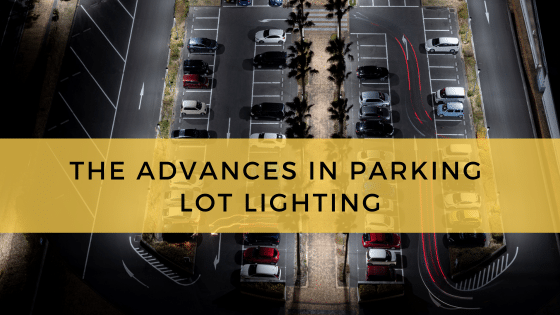
Parking lots have been a vital part of the American landscape for many decades, and parking lot lighting has improved greatly over the years. Some of the most recent advancements in parking lot lighting include:
- LED parking lot lights
- Fixture shielding for LED lights
- Smart controls for parking lot lighting systems
- Photometric analysis for parking lot lighting design
Together, these advances in parking lot lighting provide a wealth of benefits to property owners, including better efficiency, improved performance, enhanced security and clearer visibility.
1. LED Parking Lot Lighting Improves Energy Efficiency, Reliability, Performance and Cost Effectiveness
LED lighting is the most important advancement in lighting over the past few decades. It appears that commercial property owners agree, as LED lighting solutions have replaced metal halide, fluorescent and other options as the primary lighting technology in the country. This trend will likely continue until LED lights are found in nearly every commercial lighting application imaginable, including parking lots.
In parking lot applications, LED lighting offers the following advantages:
- Better energy efficiency – From its introduction, LED lighting has developed a reputation for being the energy efficient lighting option. Specifically, LEDs can output greater than 50 lumens per watt at the system level. Metal halides struggle to reach 30 watts per lumen. Put simply, LED parking lot lights generate more light per unit of energy.LEDs are able to achieve this for two reasons. One, the illumination-generating engine inside of an LED is far more precise, as it utilizes semiconductor technology instead of a heated filament. Two, LED lights produce directional illumination that can be aimed at the target without bulky reflectors. That means more light reaches the target. Metal halide fixtures emit light omnidirectionally, so much of it is wasted and often interferes with dark sky initiatives.
- Extended lifespan and reduced maintenance – LED lighting products are the longest-lived lighting technology available. Whereas a metal halide will only provide around 10,000 hours of illumination before replacement is necessary, LEDs provide 50,000 hours (or more) of reliable, low-maintenance illumination. Newer high-performance LEDs can last even longer – up to 100,000 hours in some instances.A longer-lasting light provides longer-lasting value, which reduces replacement and maintenance costs.
- Improved lighting performance and visibility – The initial challenge for LED lights was overcoming the performance advantage that other lighting technologies had over LEDs. That’s changed greatly in recent years and LED lighting systems now offer comparable or superior performance to metal halides and others. LED lighting solutions emit illumination evenly across the targeted surface, with minimal hotspots and shadows that could interfere with visibility.LEDs are also available in high-CRI models that can accurately render color, improving visibility at a distance and, by extension, safety for pedestrians and motorists.
- Better controllability – As a product of modern engineering, LED lighting is built for compatibility with a range of modern lighting controls. This includes dimmers, timers, photocells and occupancy controls. In parking lots, this control allows property owners to dictate exactly how their LED lights are used. When no one is in the parking lot, the LEDs can be dimmed down, and vice versa. When motorists or pedestrians do walk nearby, the LEDs can brighten up.LED lighting has more specialized uses as well, which may be useful for parking lots. For example, LEDs can be programmed to change color when a vehicle enters a parking space, which can help motorists identify an open space from a distance.
Among all the available lighting improvements on the market, switching from an older technology to LED lighting provides the greatest impact.
2. Fixture Shielding Minimizes Light Pollution and Glare on Parking Lots
Parking lot lighting fixtures must meet increasingly strict lighting ordinances, including ordinances limiting light pollution. The goal for lighting designers – and parking lot owners – is to minimize any illumination trespassing onto neighboring properties.
Fixture shielding is a proven way to do this, and LED fixtures are a good fit for shielding. LEDs can be paired with full cut-off fixtures that screen out any illumination aimed above the horizon, without loss of performance. Again, this is due to LED technology’s directional nature, as the light can be aimed downwards.
By pairing fixture shielding with LED lights, parking lot owners can guarantee minimal uplighting (a primary driver of light pollution), glare and light trespass, making it easier for property owners to stay within ordinance requirements.
3. Photometric Analysis Maximizes Lighting System Value and Performance
During photometric analysis, lighting designers use visualization software to model a client’s parking lot and simulate a variety of lighting layouts. This enables the property owner to see how the system will look and perform once installed and in use.
The primary advantage with photometric analysis is that it ensures the lighting solution meets the client’s needs in terms of performance, efficiency and compliance with local lighting ordinances. Photometric analysis can tell the lighting designer exactly how much light each part of the parking lot is receiving, down to the square foot and footcandle.
Photometric analysis software also simulates using lighting data direct from the manufacturer. In other words, there is no guesswork involved, as each fixture behaves in the software as it would in a real-world application. The result is optimal energy efficiency and performance before a single fixture is installed.
LED Lights are Leading the Way in Parking Lot Lighting Advances
Parking lot lighting has taken major steps forward in recent decades, with LED lighting foremost among those advancements. Compared to parking lot lights from just a few decades ago, modern parking lot fixtures perform better, require less energy to operate, are easier to control and produce minimal lighting pollution. If your business is ready to improve its parking lot lighting, work with a reputable lighting expert for a photometric analysis that will ensure the best results for your property.






